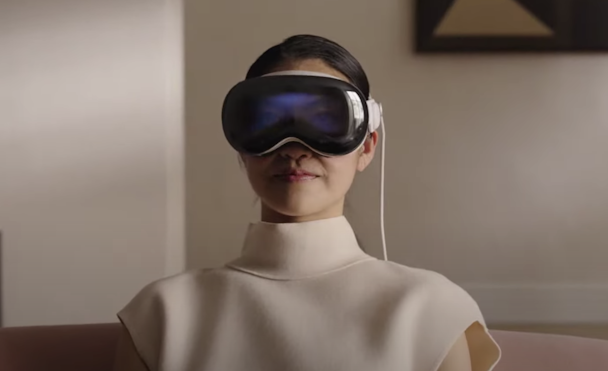What you need to know about Apple’s new Vision Pro headset
The tech giant’s highly anticipated AR/VR goggles are controlled by the user’s eyes, voice and hands.

The Vision Pro headset includes an aluminium frame and a glass screen. / Apple
Apple has finally unveiled its first AR/VR headset, which has long been shrouded in a fog of rumor and speculation.
The headset, dubbed the Vision Pro, has a ski goggle-esque form factor slightly resembling that of the headsets worn in the sci-fi flick, Ready Player One. While wearing the headset, users can transition between AR (visual elements superimposed onto the physical world) and VR (a completely virtual space) via a small toggle device located on top of the headset.
Advertisement
"Vision Pro is a new kind of computer that augments reality by seamlessly blending the real world with the digital world," Apple CEO Tim Cook said in a livestream of the 2023 WWDC. "You can see, hear and interact with digital content, just like it's in your physical space ... With Vision Pro, you're no longer limited by a display; your surroundings become an infinite canvas."
The goggles are rounded with an aluminum frame and fronted with a glass screen.
In contrast to other popular VR headsets like the HTC Vive and Meta Quest, Apple’s new Vision Pro headset does not come with handheld controllers. Rather, users operate the device with their eyes (you can scroll through icons simply by looking at them), voice and bare hands. Additionally, whereas the Vive and the Quest are worn using multiple straps that fit around and over one’s head, the Vision Pro uses a single strap that fits around the back of the head (further adding to the form and feel of ski goggles).
“This is the most advanced tech product ever created,” says futurist and author Cathy Hackl. “This device ... will take entertainment and communications to the next level. Brands will be forced to think about experiences in ways they’ve never had to do before, from spatial audio to spatial experiences.”
The Vision Pro will be priced at an eye-watering $3,499 and will be released in early 2024.
Apple’s new headset arrives during a moment of significant change for the tech industry. Until recently, some big tech companies (notably Meta) as well as marketers hailing from a broad range of industries were bullish on the concept of the metaverse, a vaguely defined virtual realm where it was widely believed, large numbers of people would congregate in the form of virtual avatars to work, play, date and do just about everything in between. But despite Meta founder and CEO Mark Zuckerberg’s best efforts, most people have yet to be sold on the metaverse. Meta was forced to start trimming the size of its workforce shortly after the release of the Quest Pro — the latest iteration of the company's VR headset — in October. A growing number of tech companies, meanwhile, have become enchanted with the latest innovations in artificial intelligence (IA) – a technology that offers radical new promise for creative industries, including marketing.
Advertisement
The biggest difference, arguably, between Apple’s Vision Pro headset and Meta’s flagship headset is that the former is positioned primarily as an AR headset – a tool capable of deepening and enriching one’s experience of the real world, instead of cutting them off from it.
Apple chief executive Tim Cook, who spearheaded the announcement of the headset earlier today, has long been critical of VR for exactly that reason. In October, he told a Dutch news outlet that while VR is “certainly something you can immerse yourself in,” he didn’t “think [you’d] want to live your whole life that way.” In that vein, the demo video for the Vision Pro headset emphasized interpersonal connection; one scene showed a man sitting on a couch, watching what appeared to be a video recording of his two daughters playing. (Not at all like a scene from Minority Report.) Another scene demonstrated one of the headset’s new features, which reveals the wearer’s eyes when another person walks up to them.
Suggested newsletters for you
Brands are likely to respond to the release of Apple's Virtual Pro headset – a landmark moment in the fields of AR and VR – in various ways, according to Code and Theory co-founder and executive chairman Dan Gardner. On the one hand, “brands have the opportunity to think long-term and invent new use cases that could be disruptive and innovative as the [AR/VR] hardware continues to evolve.” At the same time, Gardner says he anticipates “some fake experts to rise from the metaverse ashes, thinking short-term and [implementing] some stunty but probably ineffective business ideas.”
For more on the latest happening in AI, web3 and other cutting-edge technologies, sign up for The Emerging Tech Briefing newsletter here.

